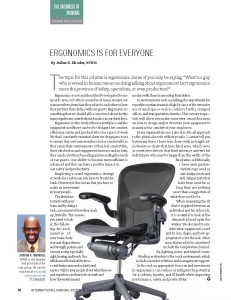The topic for this column is ergonomics. Some of you may be saying, “What is a guy who is versed in human resources doing talking about ergonomics? Isn’t ergonomics more the province of safety, operations, or even production?”
Ergonomics is not and should not be relegated to one specific area, as it affects a number of issues around our team members, from how they relate to each other to how they perform their duties with our guests. Ergonomics is something that we should all be concerned about for the many significant contributions it makes in our daily lives.
Ergonomics is the study of how a workplace and the equipment used there can best be designed for comfort, efficiency, safety, and productivity. One aspect of work life that I constantly examine is how we design processes to ensure that our team members feel as comfortable as they can in their environments. If they feel comfortable, their satisfaction and engagement increase and, in turn, they can do a better job meeting and exceeding the needs of our guests. Our ability to become more efficient is enhanced and that can have a positive impact on our safety and productivity.
Employing a sound ergonomics strategy at work does not mean you have to break the bank. However, it does mean that you have to make an investment in your people.
The first place to start is with your team and by doing a basic assessment of how they stack up, literally. This means you need to look at the following for each member of your team: body size and shape, fitness and strength, posture, and sensory acuity, especially sight, hearing, and touch. You will also need to look at the stresses and strains on muscles, joints, and nerves. Talk to your people about what they see and experience in their roles at work and how the environment meshes with them in executing their duties.
In environments such as parking, the opportunity for repetitive motion trauma is high because of the extensive use of small spaces such as cashier’s booths, cramped offices, and transportation shuttles. This cursory inspection will allow you make some very sound decisions on how to design and/or structure your equipment to maximize the comfort of your employees.
Many organizations use a one-size-fits-all approach to the physical needs of their people. I cannot tell you how many times I have seen chairs with no height adjustments or chairs that have fixed arms, which serve as restrictive devices that limit entrance and exit for individuals who may be larger than the width of the fixed arms. Additionally, I have seen garden-variety rugs used as anti-fatigue mats and anti-fatigue mats that have been used for so long they are nothing more than a suggestion of what they used to be.
When examining the fit that is required between an individual and his or her job, it is essential to look at the demands placed upon the worker. You also need to consider what equipment is used and its size, shape, and how appropriate it is for the task. Other areas that need to be considered include the temperature, humidity, lighting, noise, and related issues. Finally, pay attention to the social environment, which includes member relations and management support.
In the end, an appropriate focus on and investment in ergonomics can reduce or mitigate the potential for accidents, injuries, and ill health while improving performance, safety, and productivity.
JULIUS E. RHODES, SPHR, is the founder and principal of the mpr group. He can be reached at jrhodes@mprgroup.info or 773.548.8037
TPP-2012-01-Ergonomics is for Everyone

